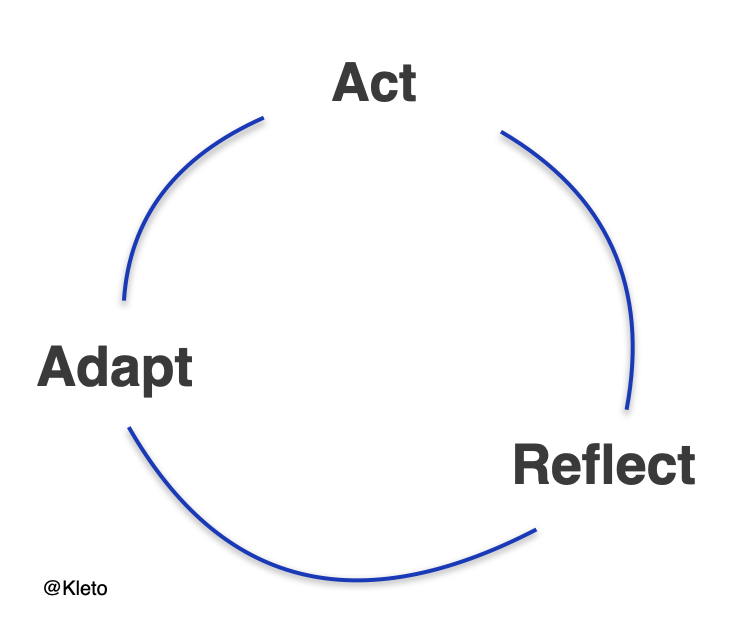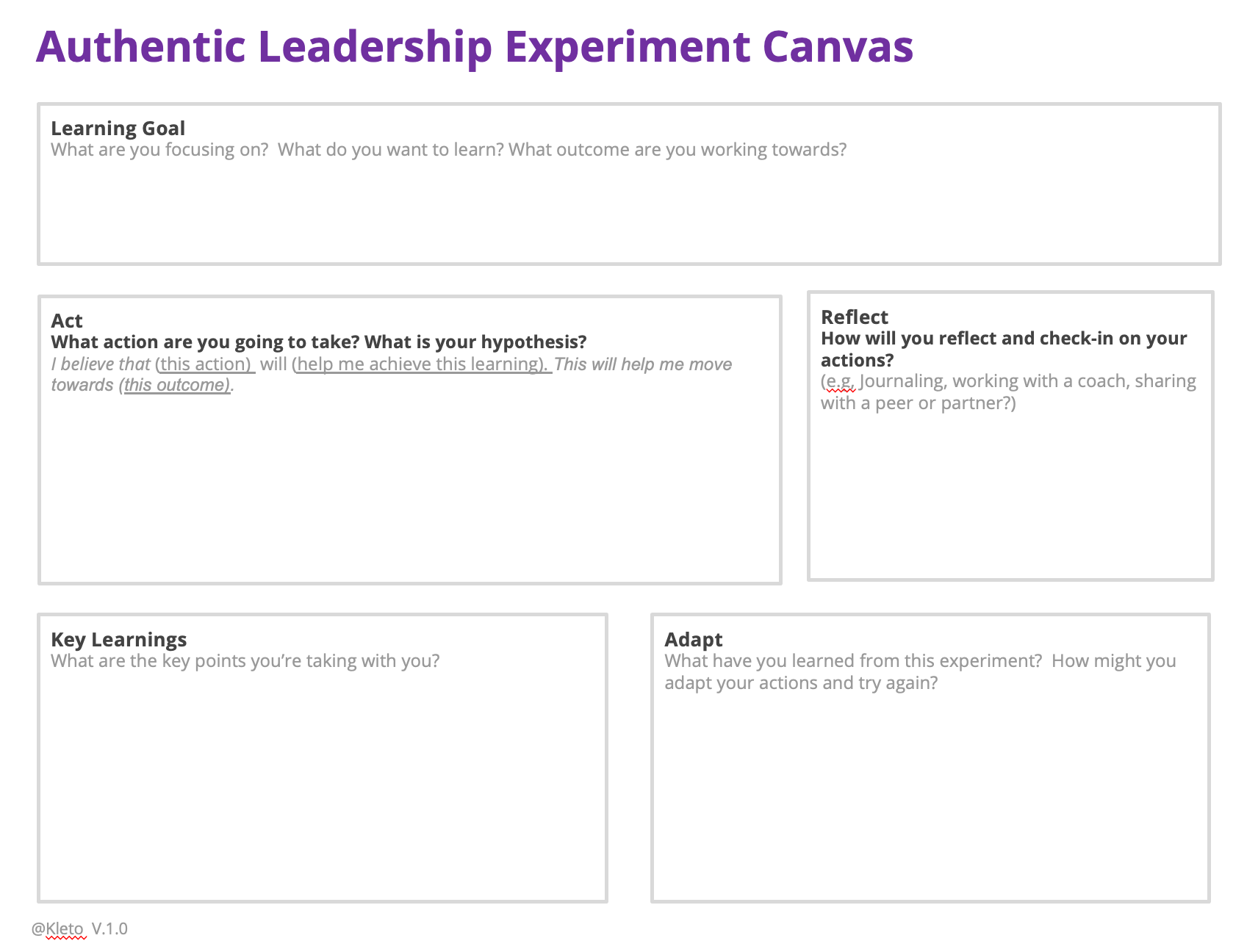Continuous Self-Discovery: Taking your Product Leadership skills to the next level
Moving into a Product leadership role or further up the leadership ladder is an exciting time. For many people, though, the celebration quickly shifts as questions about what comes next and a nagging sense of self doubt emerges from within. Research shows that one of the best ways to find your feet in a new or evolving leadership role is through experimentation and learning by doing. Below, I introduce an approach to learning and experimentation that will help you do just that.
"The only way we grow as leaders is by stretching the limits of who we are - doing new things that make us uncomfortable but that teach us through direct experience who we want to become."
-- Herminia Ibarra, author and professor at INSEAD
A big focus in my coaching sessions recently has been the transition clients are going through as they move into their first product leadership roles or move further up the leadership ladder. The moment that the promotion or new role comes through brings a great feeling of celebration - as it should! - but shortly after, questions and doubts start popping up. For example:
“How do I give feedback and direction to a team that I used to be part of? It feels forced and awkward.”
“How do I influence my new peers - they’re all C-level!?”
“How do I take on feedback now - it feels way more personal than it did when I worked on specific products.”
“What is leadership anyway? What am I supposed to do now?”
Moving from a senior contributor role to a leadership role (be it an independent contributor or people manager) is an awesome and exciting opportunity, but it’s not easy. It means moving outside of the comfort zone that you’ve created with all your work to date and learning a new set of skills and behaviors to layer on top.
The focus of your work is less about learning a new functional skill to upskill your product expertise, and more about understanding who you are, how you show up, your values, emotions, behaviors, how others respond to you, and much more. While you may have had a good sense of all this in your previous role, as executive coach and author Marshall Goldsmith says, “What got you here, won’t get you there!”
A first step in making the move into leadership is realizing that it is a transition. For some, it’s even a transformation. In my opinion, the myth of “natural-born leaders” is just that. Leadership is not something you are just given - or not - at birth. It requires skill and a continuous commitment to learning about your craft and, more importantly, about yourself.
To step into leadership means beginning a cycle of continuous self-discovery that enables you to develop your own authentic leadership style and approach. It’s based on learning about yourself and how your behaviors impact and influence those around you. (I think it’s key to remember that as Product leaders, who you influence can range from your team members and stakeholders to colleagues, executives, and your users.)
Research from Ibarra (who I quoted at the beginning of this article) and others shows that one of the best ways to start this work is by taking action and actually trying out different approaches to things like communication, feedback and influence in small, safe and considered ways; through experiments that resemble what we might run in product discovery.
Learning about leadership and developing leadership skills through experimentation isn’t as odd as it might sound. The concept of “learning by doing” and experiential learning is considered by educators and trainers to be one of the best ways for adults to learn new skills.
With that in mind, below I’ll introduce a light-touch approach to building and running your own authentic leadership experiments and creating continual opportunities to learn about yourself as you go along.
"What we have to learn to do, we learn by doing"
- Aristotle
Getting to know yourself is a never-ending process. It's not the kind of goal that you can check off a list and forget about, because there is always more to learn. In fact, I would argue that the true goal is not to "know thyself" and build a final approach to leadership, but rather to learn how to create an intentional cycle of learning about yourself; one that can adapt and evolve as you learn. Building that kind of cycle into your life will help to ensure that you're always growing and gaining a deeper understanding of yourself and your own internal story. Here's how to start creating that cycle:
Step 1: Create Learning Goals for focus
As you’ll see on the canvas below, the first step is to create learning goals for yourself that help you to define the space you’d like to focus on in a non-judgemental way.
The canvas can be used to outline multiple experiments for one learning goal, or just one experiment for one goal, it’s up to you! If you’re new to building experiments like this, I’d recommend starting with one goal and one experiment and going from there.
Unlike performance goals that are measured in a very quantitative, binary way - the focus of these goals is on learning, not getting something right the first time or hitting a specific number. Stanford University professor and author Carol Dweck defines learning goals as “reflect(ing) a desire to learn new skills, master new tasks, or understand new things — a desire to get smarter.”
Leadership learning goals for a Product leader could be something like:
Learn how to give feedback to my team members so that they feel motivated and not frustrated.
Learn more about how I respond to conflict and tension so that I can manage that response effectively.
Learn more about storytelling so that I can better convey my ideas and influence others.
Learn more about how to manage my internal imposter so that I can begin to build my confidence.
As I’ve said in my past article on goals, learning goals give space for trial, error, and experimentation to drive our progress towards a goal. They are not set in stone and can be adapted and iterated on as you learn more.
When you’re creating your learning goals, try to adopt a mindset of curiosity and be very cautious of stepping into self-judgment, and let the words you use reflect that. This exercise is not about being harsh on yourself or feeding self-doubt. It's an opportunity to identify areas that you want to explore, play, and grow. If you're not sure what to start with, my article on finding your leadership edge can point you in a good direction.
Step 2. Take Action
Now that we have a space identified to focus on, it’s time to build an experiment and take action.
As with any experiment, we start with a hypothesis that states what action you're taking in service of your learning goal, and what you hope to achieve with the action. Remember, you shouldn’t expect to get your hypothesis 100% right the first time around, so be willing to play with this. Also, don’t get too caught up in the wording of your hypothesis. This is for your use, no one else will be judging or questioning your words. For that reason, I’ve included a very simple hypothesis structure that you can try:
I believe that (this action)
will (help me achieve this learning).
This will help me become/move towards (this outcome).
For instance, if your learning goal is focused on learning more about how you react to conflict and tension at work, you might start with an experiment that centres on making a point of noticing your internal reaction to tense situations and reflecting in your journal or with a friend/colleague. How does just noticing and acknowledging your reaction change what's happening inside you and how you react to tension next time?
Learning Goal: Learn more about how I respond to conflict and tension so that I can manage that response effectively.
Action: After our next heated team meeting, I’m going to write down what I was feeling and note how I reacted and felt.
Hypothesis: I believe that noticing and capturing how I respond to a heated team meeting will help me build awareness of how I respond to conflict. This will help me become more calm in times of tension.
Try it out! As you’ll see, the experiment is key to the continuous self-discovery cycle, because it provides you with new, evidence-based knowledge. This is the jump-off point for the next part of the cycle, Reflect.
Step 3: Reflect on your actions
Research shows that regularly reflecting on our actions makes us more productive and effective. To set ourselves up for reflection success, it’s important to identify what you're going to do to process your actions. Whether it's talking to a coach or friend, journaling, or even sharing with a partner, find a way that works for you to reflect and process your actions and the outcome - be it big or small. Then capture those learnings on the canvas.
Continuing with the example from above, perhaps you discover that noticing and thinking about your reaction doesn't really change the reaction itself, but it does make you aware of it, what it feels like, and how that feeling is impacting you.That’s all solid data that you can build on.
Make sure you can capture your reflections on the Experiment Canvas. Taking time to actually write down your thoughts can help you process your thinking - and who knows - maybe this will become the beginning of your own reflection habit of journaling daily, or regularly meetings with a coach or peer.
Step 4: Adapt and integrate
With that knowledge, you can set up another experiment. This is the final part of the cycle, Adapt.
Adapting is about integrating the knowledge and insight you gained from the Act and Reflect parts of the cycle. This is where you devise a new experiment, one that will challenge or expand upon what you learned in the previous experiment. In the case of managing your internal reaction to conflict, this might involve taking the knowledge you gained about your reaction, and then finding out what other people have done to successfully manage that reaction. From there you can try implementing one or more methods of managing that kind of reaction.
For instance, you might decide that when you feel your heart start to race and your hands start to sweat in response to conflict, you're going to take five or six deep, slow breaths to help ground yourself.
Once you decide on an action to take, the experiment and act-reflect-apply cycle can start again.
Building a continuous cycle of leadership experimentation
While the canvas supports your leadership development experiments in a seemingly linear way, it’s actually a very cyclical approach that is an incredibly powerful way to grow as a leader, with each action leading to reflection and opportunities to learn that you can continue to build on.
As you consistently tap into the Act-Reflect-Adapt cycle, it will help you find answers to challenging questions and handle those moments of self doubt that tend to hit us all when we step into leadership roles. Experiment by experiment, you’ll become more comfortable and familiar with who you really are as a leader.
If you’d like a copy of the Authentic Leadership Experiment Canvas, please get in touch. The canvas itself is quite dynamic and continually being revised, so please share with me any feedback you may have as you try it out.
Subscribe
Sign up with your email address to receive Product Leadership news and updates.


